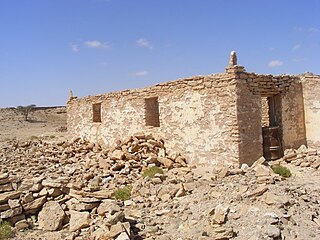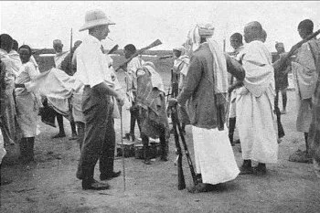
The Habar Yoonis alternatively spelled as Habr Yunis is a major clan part of the wider Isaaq clan. As descendants of Ismail bin Sheikh Isaaq, its members form a part of the wider Habar Magaadle confederation which constitutes the largest sub-clan of the Isaaq.
The Dhulbahante is a Somali clan family, part of the Harti clan which itself belongs to the largest Somali clan-family — the Darod. They are the traditional inhabitants of the physiographic Nugaal in its topographic sense, and its pre-independence administrative sense, which included Doollo. The clan's progenitor is buried at Badweyn.
The Habr Garhajis also contemporarily known as the Garhajis is a major clan of the wider Isaaq clan family. They are the traditional holders of the Isaaq Sultanate and Habr Yunis Sultanate since the 18th century. As descendants of Ismail bin Sheikh Isaaq, its members form a part of the Habar Magaadle confederation, and they constitute the largest sub-clan of the Isaaq. The Garhajis are divided into two major sub-clans: the Habr Yunis and Eidagale. They are traditionally nomadic pastoralists, merchants and skilled poets.

The Battle of Dul Madoba was an engagement between British forces and the Dervish movement on 4 August 1913. During the battle, Ibraahin Xoorane killed Richard Corfield. A native Somali account of the battle is found in the poem Annagoo Taleex naal.

Muḥammad ibn 'Abdallāh Hassan was a Somali religious, political, and military leader who founded and headed the Dervish movement, which led a Holy war against British, Italian, and Ethiopian intrusions in the Horn of Africa. He was famously known by the British Empire as the Mad Mullah. In 1917, the Ottoman Empire referred to Hassan as the "Emir of the Somali". Due to his successful completion of the Hajj to Mecca, his complete memorization of the Quran and his purported descent from the Islamic prophet Muhammad, his name is sometimes preluded with honorifics such as Hajji, Hafiz, Emir or Sayyid. His influence led him to being regarded the “Father of Somali nationalism”.

The Harti, (Somali: Harti, Arabic: هرتي, lit. 'strong man'), are a Somali clan that trace their lineage back to SalehAbdi (Harti). They are a sub-clan of the larger Darod clan. Notable sub-clans within Harti include the Majeerteen, Dhulbahante, and the Warsengeli. They predominantly reside in the apex of the Horn of Africa and its surrounding regions. Furthermore, in the southern territories, the clan's settlements span both sides of the Kenya-Somalia border.

Taleh is a historical town in the eastern Sool region of Somaliland. The town served as the capital of the pre-independence Dervish movement.

Buuhoodle, also known as Bohotle, is the largest city in the Togdheer region of Somalia. It serves as a significant border town for the movement of goods between Somalia and the Somali Region of Ethiopia. The surrounding district is rich in livestock with growing agricultural activities.

The Dervish Movement was a popular movement between 1899 and 1920, which was led by the Salihiyya Sufi Muslim poet and militant leader Mohammed Abdullah Hassan, also known as Sayyid Mohamed, who called for independence from the British and Italian colonisers and for the defeat of Ethiopian forces. The Dervish movement aimed to remove the British and Italian influence from the region and restore the "Sufi system of governance with Sufi education as its foundation", according to Mohamed-Rahis Hasan and Salada Robleh.
Haroun, also called Fadhiweyn, and natively transliterated as Xarunta in Somali, was a government and headquarters of the Dervishes, headed by Faarax Mahmud Sugulle. According to Claude Edward Marjoribanks Dansey, the political officer in the British Somali Coast Protectorate consisted of 400 individuals. The capture of the haroun was regarded as conceivably resulting in the Sayyid's surrender. In the third expedition, major Paul Kenna was tasked "by every means" to find where the haroun is.
Haji Yusuf Barre was the commander at the battle of Jidbali, the largest and deadliest engagement between the dervishes and the British empire in the Horn of Africa. Haji Yusuf Barre is also noted for being the person whom held the last stand at the Dhulbahante garesa at Taleh, in the aftermath of the bombings at Taleh wherein Taleh became the first place to be targeted in Africa through aerial attacks.

Wadamago is a historic town in Aynabo District, in the Sool region of Somaliland.
Ciid or 'Iid is an archaic native geographic name for the land between the region of Mudug and the Nugaal Valley, roughly congruous with the northern Bookh district in Ethiopia. As such, Ciid constitutes the tripoint of the two former colonial powers Britain and Italy, as well as neighboring Ethiopia, thus situating Mudug immediately southeast of Ciid, the Nugaal Valley immediately north of Ciid, and Haud to the west of Ciid. One historian referred to it as the syrup-colored land and it is today embodied by Ciid towns such as Futoxum, Magacley, Qoriley, Biriqodey, Beerdhiga and Gumburka Cagaare.

Annagoo Taleex naal, which in Somali literally means Residing in Taleh, is an August 11, 1913, poem in the Somali language by Ismail Mire which chronicles life at Taleh and the killing of colonial figurehead Richard Corfield. The poem was created two days after the death of Richard Corfield at the hand of Xirsi Cartan Boos.

The Mohamoud Garad is a Somali clan. Its members form a part of the Dhulbahante, a sub-division of the Harti/Darod clan-family. The clan is divided into three main sub-clans ― namely the Jama Siad, the Ugaadhyahan and Omar Wa’eys.

The Farah Garad or the Garad Farah is a Somali clan which is part of the Dhulbahante clan-family, a sub-division of the larger Harti/Darod clan. The Farah Garad are divided into two sub-clans — Yassin Garad and Abdalla Garad. Abdalla has four clan eponyms, Ahmed Garad, Mohamed Garad (Baharsame), Guled Garad (Barkad) and Ali Garad. They are largely significant in Sool and Togdheer regions of Somalia, and Dollo Somali region of Ethopia.

The Baho Nugaaleed the leader baho nugaaleed Khair Abdi [Qayaad], is a division of Somali clan that is part of the Dhulbahante clan-family. The primary homeland of these clans include the regions of Sool and Sanaag And Dmco Doollo DDS in SSC KHAATUMO, the Lower Juba region in Somalia and the Dollo Zone in Ethiopia. The Bah Nugaaleed are composed of three major sub-groups Qayaad Majors in accordance with their locality in the SSCD regions. These groups are Khair Abdi [Qayaad] the Hayaag Yaxye ugaasyo the Reer Aymeed and Reer Nugaaleed _Reer hawud [KhAIR ABDI]Qayaad).
The Dhulbahante Garadship is presumed to have begun in the 16th century with Garad Shishore assuming the royal title in approximately 1530. During the 19th century, the Dhulbahante garadate morphed into a dual monarchy. The current Garad, Garad Jama Garad Ali hails from this long line of succession.

Garad Jama Garad Ismail Duale is the third-highest traditional leader in the Sool region of SSC-Khaatumo State of Somalia











